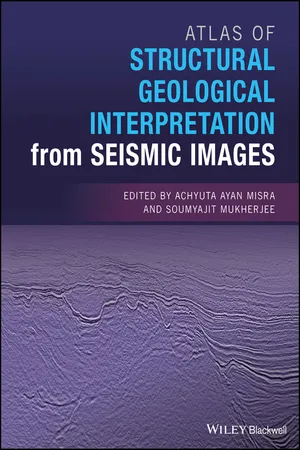
Atlas of Structural Geological Interpretation from Seismic Images
- English
- ePUB (mobile friendly)
- Available on iOS & Android
Atlas of Structural Geological Interpretation from Seismic Images
About this book
This comprehensive book deals primarily with reflection seismic data in the hydrocarbon industry. It brings together seismic examples from North and South America, Africa, Europe, Asia and Australia and features contributions from eleven international authors who are experts in their field. It provides structural geological examples with full-color illustrations and explanations so that students and industry professionals can get a better understanding of what they are being taught. It also shows seismic images in black and white print and covers compression related structures.
Representing a compilation of examples for different types of geological structures, Atlas of Structural Geological Interpretation from Seismic Images is a quick guide to finding analogous structures. It provides extensive coverage of seismic expression of different geological structures, faults, folds, mobile substrates (shale and salt), tectonic and regional structures, and common pitfalls in interpretation. The book also includes an un-interpreted seismic section for every interpreted section so that readers can feel free to draw their own conclusion as per their conceptualization.
- Provides authoritative source of methodologies for seismic interpretation
- Indicates sources of uncertainty and give alternative interpretations
- Directly benefits those working in petroleum industries
- Includes case studies from a variety of tectonic regimes
Frequently asked questions
- Essential is ideal for learners and professionals who enjoy exploring a wide range of subjects. Access the Essential Library with 800,000+ trusted titles and best-sellers across business, personal growth, and the humanities. Includes unlimited reading time and Standard Read Aloud voice.
- Complete: Perfect for advanced learners and researchers needing full, unrestricted access. Unlock 1.4M+ books across hundreds of subjects, including academic and specialized titles. The Complete Plan also includes advanced features like Premium Read Aloud and Research Assistant.
Please note we cannot support devices running on iOS 13 and Android 7 or earlier. Learn more about using the app.
Information
1
Introduction to Seismic Data
1.1 Seismic Reflection Method






1.2 Seismic Data Acquisition
Table of contents
- Cover
- Title Page
- Table of Contents
- Contributors
- Preface
- Acknowledgements
- 1 Introduction to Seismic Data
- 2 Seismic Structural Analysis
- Part I: Faults
- Part II: Folds
- Part III: Mobile Substrates
- Part IV: Tectonic/Regional Structures
- Index
- End User License Agreement